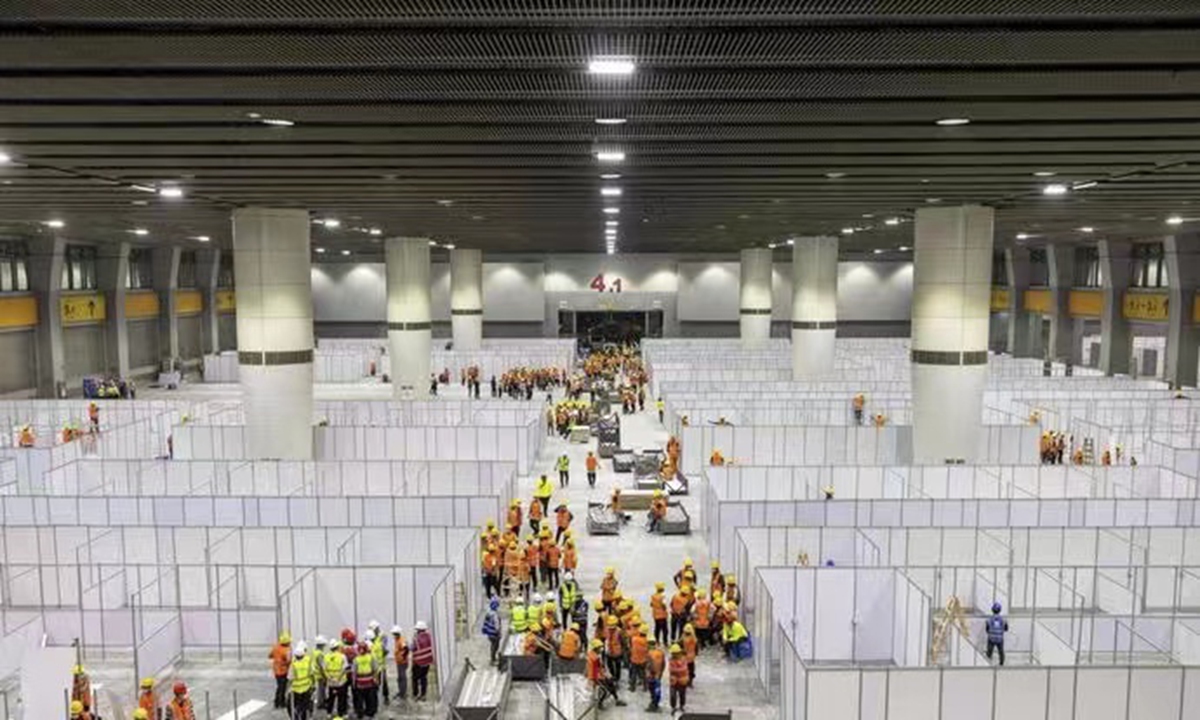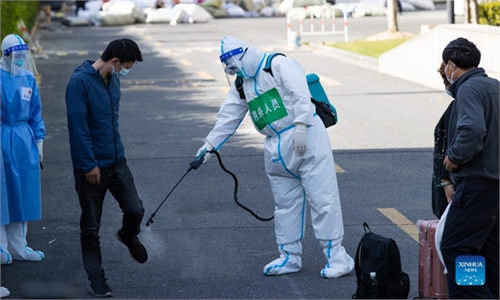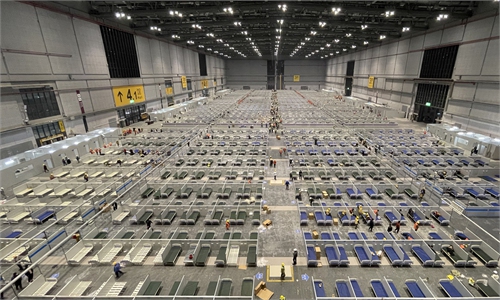
The construction of the makeshift hospital in the exhibition hall of the China Import and Export Fair in Pazhou district,south China's Guangdong Pronvince. Source:Southcn
Local authorities in Guangzhou, South China's Guangdong Province, announced on Sunday that they are renovating part of the exhibition hall of the world-renowned China Import and Export Fair into a makeshift hospital amid the latest COVID-19 spike.
Wu Linbo, deputy secretary general of Guangzhou city government, confirmed at a press conference on Sunday that according to the national epidemic prevention and control requirements which require each province to prepare two to three makeshift hospitals, Guangzhou is working on the construction of the makeshift hospital in the exhibition hall of the China Import and Export Fair in Pazhou district. A total of 23 cases have been reported in Guangzhou since Friday.
Wu's remarks came after a video circulating on social media on Saturday that shows some constructors building makeshift hospitals inside the exhibition hall, with white cubicles being quickly erected. The video was later verified by Caixin Magazine.
An employee at a hotel next to the venue told the Global Times on Sunday that a makeshift hospital was indeed under construction as workers could been seen carrying building materials inside the hall.
"The construction of the makeshift hospital has no significant impact on the operation of our hotel, and other businesses around are also operating normally," the employee said.
More than 1,500 workers have been working on the site on a 24-hour basis since Saturday, renovating five pavilions in the center that are being used for the makeshift hospital. One pavilion has been basically formed, and it is expected to be completed and put into use within a week, local authorities said at the press conference on Sunday.
The makeshift hospital in the Pazhou district will directly use different pavilions to set up three areas: polluted area, semi-polluted area and clean area, with a total of 3,450 designed beds, according to Caixin.
"Cubicles can be prefabricated on a large scale, and materials can be re-assembled upon admission. A large-scale makeshift hospital can be completed within a month, and the construction period can be shortened to one week in case of emergency," Caixin reported, quoting a source familiar with the matter.
"The construction of makeshift hospitals should not be directly linked to the severity of the local epidemic," an epidemic prevention expert told Caixin.
Under the current epidemic situation, makeshift hospitals are still a better way to implement centralized quarantine for mild cases and every province in China should have at least 2 to 3 makeshift hospitals, Jiao Yahui, director of the NHC's medical administration bureau, said at a press conference on March 22.
Jiao noted that 33 makeshift hospitals have been built or are under construction in 19 cities in 12 provinces, of which 20 have been built and 13 are under construction, with a total of 35,000 beds. These makeshift hospitals are mainly concentrated in Jilin, Shandong, Yunnan, Hebei, Fujian and Liaoning provinces.
There is a precedent for building makeshift hospitals using large exhibition halls in China. Cities such as Wuhan have used makeshift hospitals since the COVID-19 outbreak in early 2020. The pavilion of the China International Import Expo in Hongqiao, Shanghai, has been converted into a makeshift hospital, with a total designed bed capacity of 50,000.
Guangzhou is also the first city in China to establish centralized quarantine facilities for inbound passengers. The city built an "International Health Station" covering an area of 250,000 square meters in June 2021 and it was officially put into use on November 5 of that year. The site was located far from the urban area and 5,000 independent rooms were set up to accept quarantined inbound passengers.
The most important function of the pavilion of the China Import and Export Fair - also called the Canton Fair - was to host the fairs twice a year, in April and October. But this year's 131st China Import and Export Fair will be held online starting on April 15 for 10 days. Since the outbreak of COVID-19, the 127th, 128th and 129th Canton Fairs were held online, with only the 130th Canton Fair reinstating offline exhibition halls on a small scale.


